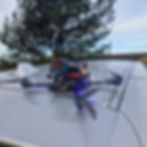
FPV drone frames have long been based around flying bricks. Most frames comprise a cuboid chassis with four arms. These narrow chassis designs don't provide much room for ancillary components, meaning antennae and ancillary devices end up being attached to the frame in a way that adversely affects flight performance.
With this in mind, and a lack of availability of "heavier" lift frames in the UK, I decided to challenge myself with designing and testing my own FPV drone frame.
I started by thinking about solving problems I've identified for relevant applications, like carrying heavier cameras for cinema work, and having redundancy and space for accessories for long range flying. This led me to decide on a 7-inch propellered frame with a wider main body than typical drone frame designs. Having a wide platform also improves core stiffness, which improves handling with a heavier camera. This would form the basis of a mini Cinelifter platform, dubbed "mini-lifter".
Arm Layout
Initially, I designed the frame in a "dead cat" layout, with the front arms further apart from each other than the back arms. This helps keep propellers out of view in camera (GoPro) footage. Whilst this is fine for GoPro and other small action cameras, it isn't necessarily well suited to heavier cameras with interchangeable lenses. When pitching forward with a heavy camera, the lack of support from the front motors can result in unwanted oscillations on pitch axis, made worse by the additional protruding weight of a lens.
To account for this, the frame has been designed to be reversible, such that it can be configured to run with wider-spaced arms at the front or back, depending on which camera and application (e.g. cinema or long-range) is required.


Aerodynamics
Many may presume that a wider platform will be less aerodynamic, and at high speeds they would be correct. However, the drag and turbulent air from the propellers plays the biggest role in aerodynamics on a FPV drone. Therefore, at cruising speeds of 40-50mph the wider platform does not adversely affect flight times, with 5-6+ minutes flight time easily achievable with just a 1300mAh 6S LiPo battery.
Even with the wider platform, testing speeds of 130km/h are achievable, which has mostly been battery limited - plenty in the tank.
The all up weight of the test drone with a GoPro comes in at under 800g, comparable to a fully loaded 5-inch freestyle drone. This makes it surprisingly agile and great for cruising at low throttle. The stiff platform also helps filter out low frequency vibrations at low throttle.
Speed v Flight Time
This frame is designed for flight time over all out speed, and whilst it isn't slow, it does have its limits. With large 7-inch propellers, torque is priority and gives this drone plenty of poke for lifting camera platforms including Blackmagic Pocket 4K and Micro Studio 4K cameras.
That being said, its handling makes it a suitable candidate for Street League racing builds and other agile applications.
Tuning
The wide platform makes tuning the drone relatively pain free. With 1300kV motors on 6S the Supafly 7 inch tune in Betaflight provides a good starting point, with some reduction to the gyro low pass filter frequency to 80Hz (from 100Hz). This can be increased again providing the motor temperatures are low and oscillations don't become worse.
Accessories
With GPS devices being so cheap and now well supported in both Betaflight and INAV, there is no reason not to fit a GPS device on board for safe recovery in the event of emergency. The wide platform allows for excellent separation of the GPS from interfering devices such as video antennae. This results in faster GPS lock and more accurate positioning.
The wide platform also provides support for battery redundancy, carrying two smaller batteries wired in parallel, rather than simply relying on one larger battery. These accessories or ancillaries improve aircraft safety and reliability, particularly for cinema and long-range applications.
These accessories can be mounted in-board of the frame using pop-out inserts, rather than having accessories dangling off the frame, leaving them exposed and at risk of damage.
Multiple mounting hole configurations are also provided to suit a variety of electronics, including common 20x20mm, 25.5x25.5mm and 30.5x30.5mm hole patterns.
Future development
Using the wider platform, I aim to produce and test 5-inch propelled X8 builds with this main chassis, as well as develop 9-inch X4 builds on a slightly wider platform. The 5-inch X8 setup will benefit high speed applications, whilst the 9-inch X4 setup will provide support for larger and high end cinema cameras.
For updates on these frame developments, please subscribe to our mailing list.
Pre-order your Latus frame here:
